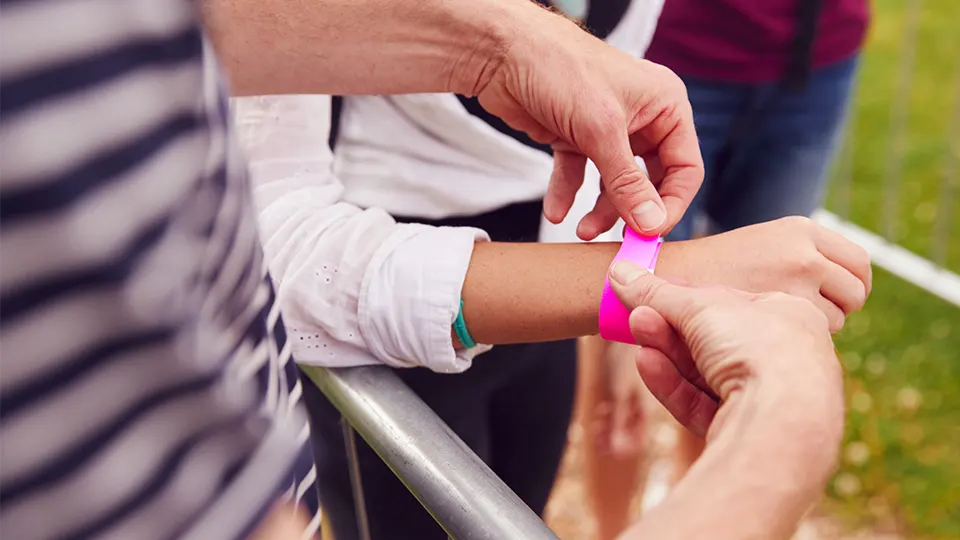
RFID is no longer a futuristic concept—it’s a practical tool reshaping how businesses engage with customers. At its core, RFID enables wireless communication between a reader and a tag through radio waves, allowing seamless data transfer, identification, and tracking. For large commercial promotion events, such as mall-wide discount festivals or loyalty reward campaigns, RFID provides a scalable, contactless solution that can dramatically enhance efficiency and customer experience.
RFID systems consist of three main components: RFID tags (embedded in wristbands or cards), RFID readers, and backend software systems.
RFID Tags: These are small electronic devices that contain a chip and antenna. In commercial events, the tags are typically embedded in NFC wristbands or PVC cards, which are easy for customers to carry and use. Most often, HF (High Frequency, 13.56 MHz) RFID tags compliant with ISO 14443 or ISO 15693 standards are used. These are ideal for short-range interactions—typically less than 10 cm—ensuring controlled access and precise transactions.
RFID Readers/Writers: Strategically placed throughout the venue, these devices emit radio waves to detect and interact with RFID tags. Readers come in different forms: fixed readers at entrances, desktop readers at information desks, and mobile readers for staff. They capture tag data and relay it to the central system in real time.
Middleware and Backend System: The middleware connects the readers to a central database, often integrated with CRM, POS systems, and event management platforms. Here, user data, promotion participation, rewards, and customer behavior are logged, analyzed, and visualized.
This triad allows businesses to automate user check-ins, deliver targeted offers, track customer flow, and analyze promotion ROI—all without manual input or physical tickets.
Implementing RFID in a commercial event requires more than just tech; it’s about designing an ecosystem that improves engagement and operational efficiency. Here’s a step-by-step breakdown of how an RFID system can be integrated into a promotional event in a shopping mall or commercial complex.
Before deployment, stakeholders should define the goal:
Drive foot traffic to specific zones
Track visitor patterns
Reward repeat visits or purchases
Encourage interactive experiences (e.g., digital lucky draws)
For short-term events, paper NFC wristbands with disposable RFID chips are affordable and effective. For long-term loyalty programs, PVC NFC cards or silicone wristbands offer durability and branding potential.
Paper wristbands: Best for single-day or weekend events.

Silicone wristbands: Reusable, waterproof, great for summer campaigns or loyalty programs.
PVC cards: Popular for mall loyalty or membership programs.
Each tag is encoded with a unique ID tied to the customer’s profile on the backend.
Install RFID readers at key interaction points:
Entrances/Exits: For tracking attendance and dwell time.
Retail Stores: To enable discounts when customers tap their band/card at checkout.
Promo Booths or Game Stations: To validate participation in activities.
Information Desks: Staff can assist users with checking points or redeeming gifts using a desktop reader.
Develop or integrate a cloud-based system that:
Registers user data upon wristband/card issuance
Logs RFID scans in real-time
Awards loyalty points or stamps automatically
Sends promotional push notifications (when paired with mobile apps or SMS)
Many events opt to outsource this to RFID solution providers who offer turnkey platforms.
Create a simple registration process:
At the mall entrance, staff hand out wristbands/cards
Visitors scan a QR code to link their wristband with a digital profile (via WeChat mini-program, mobile app, or web form)
Customers receive a welcome coupon as an incentive to register
Once live, the system begins capturing data:
Which stores are most visited
Which age group engages most
Real-time redemption of offers
Queue lengths at promo booths
Data dashboards help organizers fine-tune activities and make informed decisions mid-campaign.
In October 2023, SuperCity Mall in Shanghai launched a city-wide “Shop & Win Festival” in partnership with local retailers and international brands. Their goal: attract over 100,000 visitors during Golden Week and boost in-mall sales by 25%. Instead of traditional scratch cards or paper coupons, they embraced RFID.
The Setup
Silicone NFC wristbands were distributed to visitors upon entry, each pre-encoded with a unique UID.
Over 300 RFID readers were installed across entrances, 50+ stores, rest areas, and activity zones.
The mall launched a mobile app where customers could view their points, play mini-games (like a digital spin wheel), and redeem prizes—all linked via their RFID wristband.
Key Features
Auto-rewarding: When a customer spent over ¥200 at a participating store, they tapped their wristband at the cashier’s reader and were instantly credited with a raffle entry.
Gamification Zones: At the central atrium, RFID-enabled game booths allowed visitors to win prizes, with each game unlocking only after visiting three different stores.
Heat Mapping: Using reader data, mall operators monitored which areas had the highest engagement and adjusted staff deployment accordingly.
The Outcome
Over 130,000 wristbands were distributed over 8 days.
Participating stores reported a 32% average increase in sales.
Customer feedback showed a 92% satisfaction rate for ease of use and experience.
Mall management reported real-time insights into visitor behavior for the first time, enabling better future planning.
Moreover, the data gathered allowed targeted remarketing in the months following the event, sending tailored offers to high-spending or high-frequency customers.
Final Thoughts
RFID technology is transforming the way large commercial events are executed—from static, manual promotions to dynamic, data-driven campaigns. With seamless integration into wristbands, cards, and mobile systems, RFID offers a low-friction, high-impact solution for engaging shoppers, enhancing experiences, and optimizing business outcomes. As demonstrated in real-world cases like SuperCity Mall, the ROI is not just in numbers but in long-term customer relationships built on innovation and convenience.
As more malls, exhibition centers, and retailers adopt this technology, the future of interactive, smart promotions is no longer a question of “if” but “how soon.”
Copyright ©2025 Shenzhen DTB RFID Co., Ltd. All Rights Reserved.